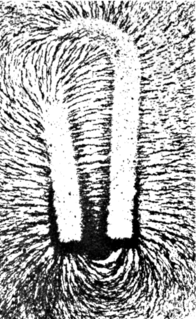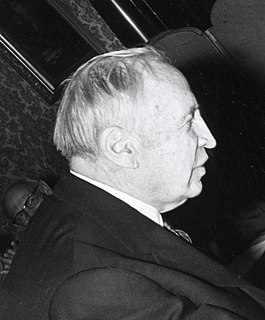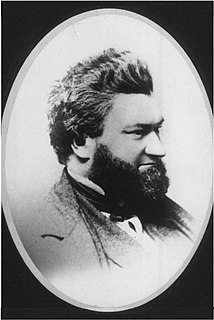
Electromagnetism is a branch of physics involving the study of the electromagnetic force, a type of physical interaction that occurs between electrically charged particles. The electromagnetic force is carried by electromagnetic fields composed of electric fields and magnetic fields, and it is responsible for electromagnetic radiation such as light. It is one of the four fundamental interactions in nature, together with the strong interaction, the weak interaction, and gravitation. At high energy, the weak force and electromagnetic force are unified as a single electroweak force.

Franz Anton Mesmer was a German physician with an interest in astronomy. He theorised the existence of a natural energy transference occurring between all animated and inanimate objects; this he called "animal magnetism", sometimes later referred to as mesmerism. Mesmer's theory attracted a wide following between about 1780 and 1850, and continued to have some influence until the end of the 19th century. In 1843, the Scottish doctor James Braid proposed the term "hypnotism" for a technique derived from animal magnetism; today the word "mesmerism" generally functions as a synonym of "hypnosis". Mesmer also supported the arts, specifically music; he was on friendly terms with Haydn and Mozart.

Ferromagnetism is the basic mechanism by which certain materials form permanent magnets, or are attracted to magnets. In physics, several different types of magnetism are distinguished. Ferromagnetism is the strongest type and is responsible for the common phenomenon of magnetism in magnets encountered in everyday life. Substances respond weakly to magnetic fields with three other types of magnetism—paramagnetism, diamagnetism, and antiferromagnetism—but the forces are usually so weak that they can be detected only by sensitive instruments in a laboratory. An everyday example of ferromagnetism is a refrigerator magnet used to hold notes on a refrigerator door. The attraction between a magnet and ferromagnetic material is "the quality of magnetism first apparent to the ancient world, and to us today".

Magnetism is the class of physical attributes that are mediated by a magnetic field, which refers to the capacity to induce attractive and repulsive phenomenon in other entities. Electric currents and the magnetic moments of elementary particles give rise to a magnetic field, which acts on other currents and magnetic moments. Magnetism is one aspect of the combined phenomenon of electromagnetism. The most familiar effects occur in ferromagnetic materials, which are strongly attracted by magnetic fields and can be magnetized to become permanent magnets, producing magnetic fields themselves. Demagnetizing a magnet is also possible. Only a few substances are ferromagnetic; the most common ones are iron, cobalt and nickel and their alloys. The rare-earth metals neodymium and samarium are less common examples. The prefix ferro- refers to iron, because permanent magnetism was first observed in lodestone, a form of natural iron ore called magnetite, Fe3O4.

Pierre Curie was a French physicist, a pioneer in crystallography, magnetism, piezoelectricity, and radioactivity. In 1903, he received the Nobel Prize in Physics with his wife, Marie Curie, and Henri Becquerel, "in recognition of the extraordinary services they have rendered by their joint researches on the radiation phenomena discovered by Professor Henri Becquerel". With their win, the Curies became the first ever married couple to win the Nobel Prize, launching the Curie family legacy of five Nobel Prizes.

A magnetic field is a vector field that describes the magnetic influence on moving electric charges, electric currents, and magnetic materials. A moving charge in a magnetic field experiences a force perpendicular to its own velocity and to the magnetic field. A permanent magnet's magnetic field pulls on ferromagnetic materials such as iron, and attracts or repels other magnets. In addition, a magnetic field that varies with location will exert a force on a range of non-magnetic materials by affecting the motion of their outer atomic electrons. Magnetic fields surround magnetized materials, and are created by electric currents such as those used in electromagnets, and by electric fields varying in time. Since both strength and direction of a magnetic field may vary with location, it is described mathematically by a function assigning a vector to each point of space, called a vector field.

A magnet is a material or object that produces a magnetic field. This magnetic field is invisible but is responsible for the most notable property of a magnet: a force that pulls on other ferromagnetic materials, such as iron, steel, nickel, cobalt, etc. and attracts or repels other magnets.

In physics and materials science, the Curie temperature (TC), or Curie point, is the temperature above which certain materials lose their permanent magnetic properties, which can be replaced by induced magnetism. The Curie temperature is named after Pierre Curie, who showed that magnetism was lost at a critical temperature.

John Hasbrouck Van Vleck was an American physicist and mathematician. He was co-awarded the Nobel Prize in Physics in 1977, for his contributions to the understanding of the behavior of electronic magnetism in solids.

William Walker Atkinson was an attorney, merchant, publisher, and author, as well as an occultist and an American pioneer of the New Thought movement. He is the author of the pseudonymous works attributed to Theron Q. Dumont and Yogi Ramacharaka.

Carl (Karl) Ludwig von Reichenbach was a chemist, geologist, metallurgist, naturalist, industrialist and philosopher, and a member of the Prussian Academy of Sciences. He is best known for his discoveries of several chemical products of economic importance, extracted from tar, such as eupione, waxy paraffin, pittacal and phenol. He also dedicated himself in his last years to research an unproved field of energy combining electricity, magnetism and heat, emanating from all living things, which he called the Odic force.

Animal Magnetism is the seventh studio album by German rock band Scorpions, released in 1980. The RIAA certified the record as Gold on 8 March 1984, and Platinum on 28 October 1991.
Albert Webster Edgerly was a 19th and 20th century American social reform activist. He believed in euthanasia programs, a healthy diet, and the power of personal magnetism, and began the Ralstonism movement as a way to live out this lifestyle.

Daniel Davis Jr. was an American science instrument maker, electrical engineer, mechanic, photographer, daguerreotypist and ambrotypist. Through the course of his work he became known for his practical knowledge and understanding of electromagnetic principles. He worked with college professors, notable electricians and popular scientists of the nineteenth century. He was consulted for practical knowledge on mechanics and electricity by inventors: including Samuel Morse for his telegraph and Elias Howe for his sewing machine. He was the first man in the United States to work with gold and silver electroplating, patented a method for coloring daguerrotypes through electroplating in 1842, and sold franchises to others for photographic studios. Davis published an exhaustive work on electromagnetism that became a textbook for academies, high schools, and colleges.

The Carnegie Institution of Washington, known also for public purposes as the Carnegie Institution for Science (CIS), is an organization in the United States established to fund and perform scientific research. The institution is headquartered in Washington, D.C. As of June 30, 2020, the Institution's endowment was valued at $926.9 million. In 2018 the expenses for scientific programs and administration were $96.6 million. As of June 22, 2022, Eric Isaacs is president of the institution.

In physics, Gauss's law for magnetism is one of the four Maxwell's equations that underlie classical electrodynamics. It states that the magnetic field B has divergence equal to zero, in other words, that it is a solenoidal vector field. It is equivalent to the statement that magnetic monopoles do not exist. Rather than "magnetic charges", the basic entity for magnetism is the magnetic dipole.
James Henry Taylor was a professor of mathematics at George Washington University from 1929–1958, and professor emeritus from 1959 until his death.
Animal magnetism, also known as mesmerism, was the name given by German doctor Franz Mesmer in the 18th century to what he believed to be an invisible natural force (Lebensmagnetismus) possessed by all living things, including humans, animals, and vegetables. He believed that the force could have physical effects, including healing, and he tried persistently but without success to achieve scientific recognition of his ideas.

Magnetism is an album by American jazz pianist Matthew Shipp which was recorded in 1999 and released on the French Bleu Regard label. The work is a twenty-movement suite composed of solo, duo and trio performances by Shipp, saxophonist and flutist Rob Brown and bassist William Parker.

The Royal Commission on Animal Magnetism involved two entirely separate and independent French Royal Commissions, each appointed by Louis XVI in 1784, that were conducted simultaneously by a committee composed of four physicians from the Paris Faculty of Medicine and five scientists from the Royal Academy of Sciences , and a second committee composed of five physicians from the Royal Society of Medicine .















